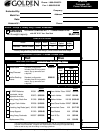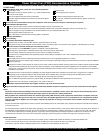
If all the LCD coverage criteria are met, add modifier KX to the PWC base code; otherwise DO NOT use modifier KX.
If the PWC is only to be used for mobility outside the home, modifier GY must be added to the base code.
This document is for educational purposes only and should not be considered legal advice.
Modifier Reminders
Items billed before a signed and dated order has been received must be submitted with modifier EY added to each affected HCPCS code.
Many suppliers have created forms which have not been approved by CMS which they send to physicians and ask them to complete. Even if the
physician completes this type of form and puts it in his/her chart, this supplier-generated form is not a substitute for the comprehensive medical
record as noted above. Suppliers are encouraged to help educate physicians on the type of information that is needed to document a patient’s
mobility needs.
See the “Documentation Requirements” section of LCD for Power Mobility Devices for a description of the pertinent information that should be documented
in a face-to-face exam.
The information that the supplier must obtain before submitting a claim to the DME contractor is described in detail in the LCD and Policy Article. However, if
the DME MAC or other Medicare Contractor asks for documentation on individual claims, additional documents (e.g., notes from prior visits, test reports,
etc.) shall also be obtained from the treating physician to provide a historical perspective that reflects the patient’s condition in the continuum of care,
corroborating the information in the face-to-face examination, painting a picture of the patient’s condition and progression of disease over time.
Supplier attestation stating that there is no financial relationship between the person completing the face-to-face examination and the supplier
The patient has not expressed an unwillingness to use a PWC in the home
NOTE:
Physicians must document the findings of the face-to-face examination in a detailed narrative note in their charts in the format that they use for
other entries. The note must clearly indicate that a major reason for the visit was a mobility examination.
The patient’s weight is less than or equal to the weight capacity of the PWC that is provided
Use of a PWC will significantly improve the patient’s ability to participate in MRADLs and the patient will use it in the home
Date stamp or equivalent documents date supplier received a copy of the face-to-face exam
The mobility deficit cannot be sufficiently and safely resolved by the use of an appropriately fitted cane or walker
The patient does not have sufficient upper extremity function to self propel an optimally-configured manual wheelchair in the home to perform MRADLs
during a typical day
The note clearly indicates that a major reason for the visit was a mobility examination.
The patient has the mental and physical capabilities to safely operate the PWC that is provided or the patient has a caregiver who is unable to
adequately propel an optimally configured manual wheelchair, but is available, willing, and able to safely operate the PWC that is provided.
The patient is unable to safely transfer to and from a POV and/or unable to operate the tiller steering system and/or unable to maintain postural stability
and position while operating the POV in the home and/or the patient’s mental capabilities and physical capabilities are not sufficient for safe mobility
using a POV in the home and/or the patient’s home provides inadequate access between rooms, maneuvering space, and surfaces for the operation of
the PWC that is provided.
Face-to-face medical evaluation meeting all of the following criteria:
The evaluation occurred
BEFORE
the physician completed 7-element written order.
The findings are documented in a detailed narrative note in the format used for other entries.
The patient has a mobility limitation that significantly impairs his/her ability to participate in one or more mobility-related activities of daily living
(MRADL) in the home
Proof of Delivery
On-site Home Assessment establishing that:
The beneficiary is able to use the PWC ordered to assist with ADLs in the home
The patient’s home provides adequate access between rooms, maneuvering space, and surfaces for the operation of the PWC that is provided
Description of the item (may be general – e.g., “power mobility device”
or may be more specific
The treating physician’s signature
Beneficiary Authorization
Has a date stamp or equivalent documenting supplier’s receipt date
The date the treating physician signed the order
Date stamp or equivalent documents date the supplier received the
written order
Lists the specific base (HCPCS code and narrative description and mfg. name/model), and
Lists all options and accessories that can be billed separately (HCPCS code and narrative description and mfg. name/model), and
Date of completion of the face-to-face examination
Pertinent diagnoses/conditions that relate to the need for the power
mobility device
Lists the supplier’s charge and Medicare fee schedule allowance for each separately billed item, and
Was signed and dated by physician; and
Written order was received within 45 days after completion of the face-to-face exam and prior to delivering POV to patient.
Detailed Product Description that:
Power Wheel Chair (PWC) Documentation Checklist
Group I PWCs HCPCS Codes K0813 - K0816 and Group II PWCs HCPCS Codes K0820 - K0829
Beneficiary’s name
Length of need
All PWC Codes
Detailed Written Order must contain ALL of the following elements:




